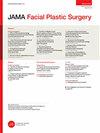Outcomes of Extracorporeal Septoplasty and Its Modifications in Treatment of Severe L-Strut Septal Deviation: A Systematic Review and Meta-analysis.
Q1 Medicine
引用次数: 10
Abstract
Importance While extracorporeal septoplasty (ECS) and its modifications have been previously studied, to our knowledge, no systematic review of surgical outcomes and complications of this technique has been performed. Objective To evaluate the evidence of surgical outcomes and complications of ECS (including modified techniques) to treat severe L-strut septal deviation defined as deviation within 1.0 cm of the caudal or dorsal septum. Data Sources MEDLINE, Embase, CINAHL, CENTRAL, Scopus, and Web of Science databases and reference lists were searched from inception to April 2018 for clinical and observational studies. Search terms included extracorporeal, septoplasty, and septum. Study Selection Selection criteria were defined according to the population, intervention, comparison, and outcome framework. Relevant studies were selected by 2 independent reviewers based on abstracts and full texts. Data Extraction and Synthesis Data were extracted using standardized lists chosen by the authors according to Cochrane Collaboration guidelines. Data were collected and synthesized with ranges reported, as well as assessment of bias and heterogeneity when applicable. Analysis started in February 2019. Main Outcomes and Measures Outcomes assessed included functional nasal airway improvement by objective measurements and subjective measurements (Nasal Obstruction Symptom Evaluation [NOSE] and visual analog scale scores); complications including bleeding, infection, dorsal irregularities, and other functional or cosmetic deficits; and as revision surgery rates. Results Of 291 records initially obtained, 31 were considered relevant after review according to PRISMA guidelines. All studies except 1 randomized clinical trial (3.2%) were observational in nature, with 21 retrospective studies (67.7%) and 9 prospective studies (29.0%). Conventional ECS was performed in 16 studies (51.6%), and modified ECS was performed in 15 studies (48.4%). The sample size varied from 10 to 567, and the mean age varied from 22.5 to 46 years. Of 31 studies, 14 (45%) were of good methodology. Meta-analysis was performed on 5 studies reporting change in NOSE scores, with pooled effect of -60.0 (95% CI, -67.8 to -52.2) points, but heterogeneity was high, with I2 = 96%. When comparing complications between modified and conventional ECS, the relative risk for infections was 0.95 (95% CI, 0.34-2.7); for bleeding, 0; for nasal dorsal irregularities, 0.29 (95% CI, 0.16-0.53); for other cosmetic complications, 4.3 (95% CI, 0.87-21.1); for other functional complications, 0.47 (95% CI, 0.20-1.1); and for revision operations, 1.4 (95% CI, 0.83-2.3). Conclusions and Relevance Of the 31 studies included in this systematic review, less than half were of good methodology, and a significant level of heterogeneity was found regarding type of outcome measure used and reporting of complications. To improve the level of evidence, better study methodology, standardization of surgical outcomes measures, and reporting of complications are needed.体外中隔成形术及其改良术治疗严重L型间隔偏移的疗效:系统评价和荟萃分析。
重要性虽然体外隔膜成形术(ECS)及其改良术之前已经进行了研究,但据我们所知,尚未对该技术的手术结果和并发症进行系统审查。目的评估ECS(包括改良技术)治疗严重L型鼻中隔偏曲(定义为尾中隔或背中隔1.0 cm以内的偏曲)的手术结果和并发症的证据。数据来源MEDLINE、Embase、CINAHL、CENTRAL、Scopus和Web of Science数据库和参考文献列表从开始到2018年4月进行了临床和观察性研究搜索。搜索词包括体外,隔膜成形术和隔膜。研究选择根据人群、干预、比较和结果框架确定选择标准。相关研究由2名独立评审员根据摘要和全文进行选择。数据提取和合成使用作者根据Cochrane协作指南选择的标准化列表提取数据。收集数据并将其与报告的范围进行综合,并在适用时评估偏差和异质性。分析始于2019年2月。主要结果和测量结果评估结果包括通过客观测量和主观测量(鼻阻塞症状评估[NOSE]和视觉模拟量表评分)改善鼻气道功能;并发症,包括出血、感染、背部不规则和其他功能或美容缺陷;以及作为翻修手术率。结果根据PRISMA指南,在最初获得的291份记录中,31份在审查后被认为是相关的。除1项随机临床试验(3.2%)外,所有研究均为观察性研究,其中21项为回顾性研究(67.7%),9项为前瞻性研究(29.0%)。16项研究(51.6%)采用常规ECS,15项研究(48.4%)采用改良ECS。样本量从10到567不等,平均年龄从22.5到46岁不等。在31项研究中,有14项(45%)采用了良好的方法。对5项报告NOSE评分变化的研究进行了荟萃分析,综合效应为-60.0(95%CI,-67.8至-52.2)分,但异质性很高,I2 = 96%。当比较改良ECS和传统ECS的并发症时,感染的相对风险为0.95(95%CI,0.34-2.7);出血,0;对于鼻背不规则性,0.29(95%CI,0.16-0.53);对于其他美容并发症,4.3(95%CI,0.87-21.1);对于其他功能性并发症,0.47(95%CI,0.20-1.1);对于翻修手术,为1.4(95%CI,0.83-2.3)。结论和相关性在本系统综述中纳入的31项研究中,只有不到一半的研究具有良好的方法学,并且在使用的结果测量类型和并发症报告方面发现了显著的异质性。为了提高证据水平,需要更好的研究方法、手术结果测量的标准化和并发症的报告。
本文章由计算机程序翻译,如有差异,请以英文原文为准。
求助全文
约1分钟内获得全文
求助全文
来源期刊

JAMA facial plastic surgery
SURGERY-
CiteScore
4.10
自引率
0.00%
发文量
0
期刊介绍:
Facial Plastic Surgery & Aesthetic Medicine (Formerly, JAMA Facial Plastic Surgery) is a multispecialty journal with a key mission to provide physicians and providers with the most accurate and innovative information in the discipline of facial plastic (reconstructive and cosmetic) interventions.
 求助内容:
求助内容: 应助结果提醒方式:
应助结果提醒方式:


